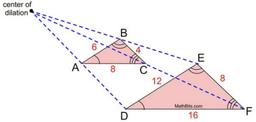
Unit 3 - Dilation/Similarity Practice Assessment
Quiz by Margaret McKinley
Feel free to use or edit a copy
includes Teacher and Student dashboards
Measure skillsfrom any curriculum
Measure skills
from any curriculum
Tag the questions with any skills you have. Your dashboard will track each student's mastery of each skill.
With a free account, teachers can
- edit the questions
- save a copy for later
- start a class game
- automatically assign follow-up activities based on students’ scores
- assign as homework
- share a link with colleagues
- print as a bubble sheet
16 questions
Show answers
- Q1Daniel dilated triangle ABC by a scale factor of 1/2 with a center of dilation of P to create triangle A'B'C'. Which of these images represents Daniel's dilation?30s
- Q2Select the explanation which describes the transformation which maps triangle BCD onto triangle B'C'D' (For the test, be prepared to write your own description.Dilation of triangle BCD by a scale factor of 1/3 from a center of dilation of point CDilation of triangle BCD by a scale factor of 3 from a center of dilation of (4,5)Dilation of triangle BCD by a scale factor of 2 from a center of dilation of (4,5)Dilation of triangle BCD by a scale factor of 330s
- Q3Triangle ABC is dilated from center P by a scale factor of 3. Determine the coordinates of A'. (You can use the DESMOS to help you with this question.)(-1,0)(0,0)(2, 0)(1,0)30s
- Q4Similar triangles can be used to determine the slope of a line. Using the given similar triangles, determine the length of the pink line segment (x). (Hint: Use Pythagorean Theorem to determine the length of the hypotenuse for the triangle with legs 14 and 12.)5.18.39.2730s
- Q5Select the answer which describes the transformation which maps triangle LNM onto triangle LJKTo map triangle LNM onto LJK, triangle LNM was reflected over a line of symmetry followed by a dilation centered at point L by a scale factor of 2.To map triangle LNM onto LJK, triangle LNM was rotated around point L by a 180 degrees then dilated by a scale factor of 2 from a center of L.To map triangle LNM onto LJK, triangle LNM was rotated around point L clockwise by a 180 degrees then dilated by a scale factor of 2.5 from a center of L.To map triangle LNM onto LJK, triangle LNM was reflected over a line of symmetry followed by a dilation from a center of L by a scale factor of 2.5.30s
- Q6Given triangle LNM is similar to triangle LJK, solve for x.15.83539.45.630s
- Q7Given triangle LNM is similar to triangle LJK, solve for y.183515.839.430s
- Q8Select the answer which completes the similarity statements for the above figure.30s
- Q9Given Triangle ABC ~ Triangle DEF, solve for y55Cannot be determined359030s
- Q10Given Triangle ABC ~ Triangle DEF, solve for zCannot be determined35559030s
- Q11True/False: The two triangles in the figure are similar.FalseTrue30s
- Q12True/False: The two triangles in the figure are similar.TrueFalse30s
- Q13True/False: The two triangles in the figure are similar.FalseTrue30s
- Q14True/False: The two triangles in the figure are similar.FalseTrue30s
- Q15Leroy is playing squash with a low net to train. The net is 0.9 m high, and Leroy is 12 m behind the net. The ball barely skims the net and hits 6 m from the net. Determine the height of the ball above the ground before the ball was hit.120 m4.5 m2.7 m0.3 m30s